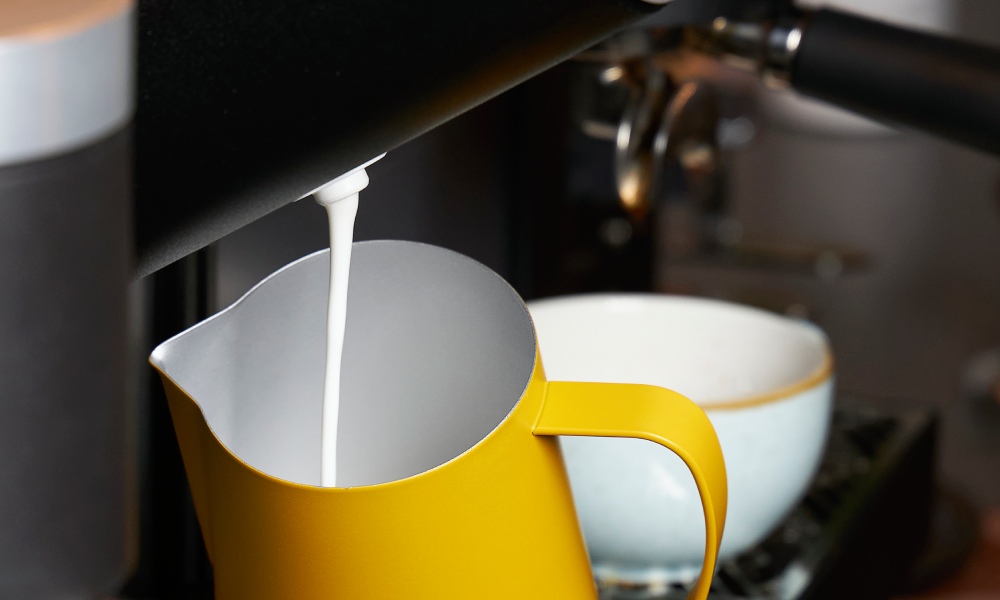When foaming milk, timing is everything
David Phillips speaks to Denes Biro about the importance of timing when foaming milk – and how automated technology can help
Of all the steps involved in making coffee, steaming milk remains one of the most highly valued and respected skills.
“For about three months we had to train and study milk – and of course coffee,” says Denes Biro, director of UK sales at Heylo Coffee – recalling his time training at Taylor Street Baristas. “We were only able to steam milk and serve it to a customer after about three months and after an exam as a junior barista.”
To achieve a velvety texture, precision is crucial. The steam wand needs to be positioned correctly within the milk jug, angled just right; it should hiss not too much, but not too little, creating a whirlpool effect that incorporates the steam into the milk without producing large air bubbles.
A less-discussed aspect is the crucial role timing plays in achieving top-quality milk. All of these steps must be completed within a narrow timeframe – too long, and the proteins responsible for the milk’s structure will begin to break down, and so will the sugars that give it its sweetness. In other words, there’s very little margin for error.
When you get it right, it can make all the difference. “When you see a well-textured, shiny latte or flat white with beautiful latte art – or even a nice heart in the middle of the cup – that’s already a high-quality beverage,” says Denes. “It’s better for customers, it’s better to look at and people are happy to pay what they pay.”
In this sense, timing plays a critical role in achieving both the right texture and temperature for milk – impacting the overall quality of the final beverage. However, this isn’t the only way timing comes into play when foaming milk.
Timing is crucial
Generally speaking, it’s easiest to draw latte art when pouring into fresh espresso. However, even experienced baristas can find it challenging to ensure that both the milk and espresso are ready at the same time – especially in a busy coffee shop.
After steaming milk, you’ll usually see small bubbles on the surface – regardless of skill level. Resting the milk for 10 to 20 seconds allows these remaining air pockets to rise to the surface of the milk and settle.
A gentle tap on the counter and a swirl of the jug can then remove these bubbles. This process is what results in truly velvety and shiny milk. However, integrating it into an already busy and complex workflow can be challenging.
Indeed, in busy coffee shops, espresso shots can sit waiting to be poured into – as they slowly degrade and their flavour begins to change. As such, steaming milk is often the pressure point on an espresso bar, and the process can be rushed.
Managing this is a challenge for any busy coffee shop – and they often end up relying on their most skilled baristas during their busiest days.
However, this may not be the case for much longer. Automated milk frothing systems are now a viable option for cafés and provide a practical solution for those struggling to consistently deliver high-quality milk.

A new way of foaming milk
Automatic milk frothing systems, like Heylo’s milk module, offer a real solution to businesses – especially those that have an over-reliance on their most skilled baristas.
Indeed, creating specialty coffee-quality milk takes months of training, which can pose a significant challenge to businesses given the high staff turnover rate within the industry. The average staff turnover rate in the US hospitality industry was 85% in 2021 – significantly higher than the national average of 47%.
While integrating this new technology may require some workflow adjustments, once the team becomes proficient with it, it has the potential to streamline operations and make coffee shops less dependent on highly skilled staff. This ultimately places them in a less vulnerable position in the context of labour problems in the coffee industry.
Furthermore, thanks to Heylo’s user-friendly interface, baristas can initiate milk preparation precisely when needed, allowing for better control over the timing of the entire process – meaning that perfect milk can be poured into freshly brewed espresso more of the time.
Beyond the improvements it can bring to workflow, this new technology can arguably improve the texture and flavour of the milk. Rather than injecting steam into it – which condenses into water and ultimately dilutes the liquid – Heylo’s steamless system uses aeration and delivers pure, frothed milk.
“With the right settings, you should get the same amount of milk, the right texture, and the same temperature every time,” says Denes. “As long as the milk is kept cold in a fridge before it’s used, and you have the right settings on the machine, the microfoam is really impressive,” says Denes.
Ultimately, achieving high-quality milk has long been a challenge for the coffee industry. It demands precision during steaming, combined with careful timing. However, by embracing new technology, coffee shops can make this task not only manageable, but relatively effortless.
New Ground Coffee
Want to read more articles like this? Sign up for our newsletter!







